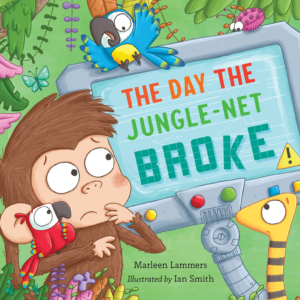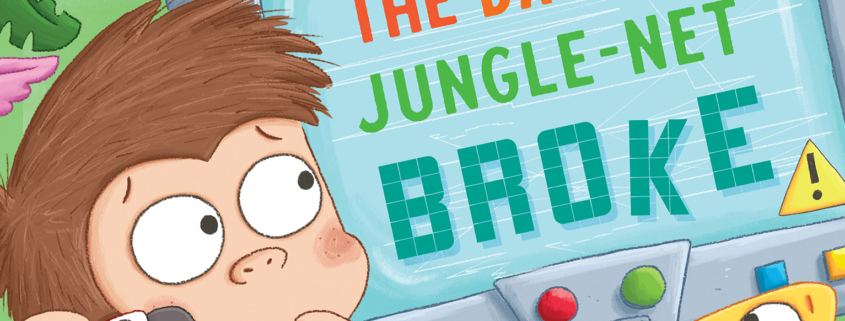The Day the Jungle-Net Broke by Marleen Lammers
The endless struggle between books and screens! Author Marleen Lammers shares some insights into how to make children’s books compete with screens.

How to make children’s books compete with screens
While anyone who’s ever looked after young children knows that screens can be a real blessing (we all cheat our way through some tricky moments!), the challenge is to not overdo it. In recent years, the negative effects of too much screen-time have become all too obvious, so we need to aim for healthy boundaries. But how do we peel our kids away from their screens and avoid tamper-tantrums in the process?
I’d like to think that books can play a role. Despite the undeniable allure of screens, books still provide something different – something quietly powerful. Whether kids are reading themselves or being read to by an adult, the experience can be magical. A good story will open a door to an imaginative place – a place to escape to. It can encourage wonder and spark creativity. Plus, getting young kids to engage with books in a positive way can also develop a life-long reading habit. And in my experience, life is better when you’re stuck in a good book. But for this to happen, for kids to fall in love with reading, the books have to grab their attention.
They have to be fun and entertaining. This seems like an obvious statement, but I worry that there’s a growing trend in children’s publishing to focus too much on didactic fiction and not enough on, well, good stories. Books need to teach kids a lesson – say the writers, editors, publishers, and booksellers of children’s books. But how do the actual consumers of these books feel about this? My worry is that the moral undertone that’s become so common in children’s literature – even in picture books – can take away from the pleasure of reading. And that’s not a good thing, if these books are to compete with ever-engaging screens. That means we’re shooting ourselves in the literary foot.
It may sound like I didn’t follow my own advice with my new picture book, ‘The Day The Junglenet Broke’, as it is trying to drive a point home; that there’s an exciting world out there beyond screens. But it’s doing so in – hopefully – a fun and playful enough way. The story is set in a colourful jungle (brought to life beautifully by illustrator Ian Smith), where animals live in ‘i-trees’ – trees with screens attached to them. The main character, a monkey called Miles, depends on his screen for pretty much everything; it wakes him up in the morning, it tells him what exercises to do, and it lets him tree-time with his cousin, who lives a few forests down. But just as he’s ordering bananas through his Just Peel app one morning, the Jungle-net goes down, and all screens freeze. Initially, Miles panics. But when he’s forced to engage with the rainforest in a different way, he has some unexpected and exciting adventures.At the end of the story, just when Miles has found a great offline monkey life, the Jungle-net comes back on. Miles and his fellow jungle creatures go back to using their i-trees – but in between real-life forest fun. I liked the idea of encouraging moderation, rather than demonising screens altogether. My hope is that this story can, in some small way, encourage kids to walk away from their screens more often. By following Miles’s example, but mostly by enjoying the fun ride of a good story. In the end, that’s the only thing that will make kids want to return to the bookshelf.
Views expressed do not necessarily reflect those of the Federation of Children’s Book Groups.



